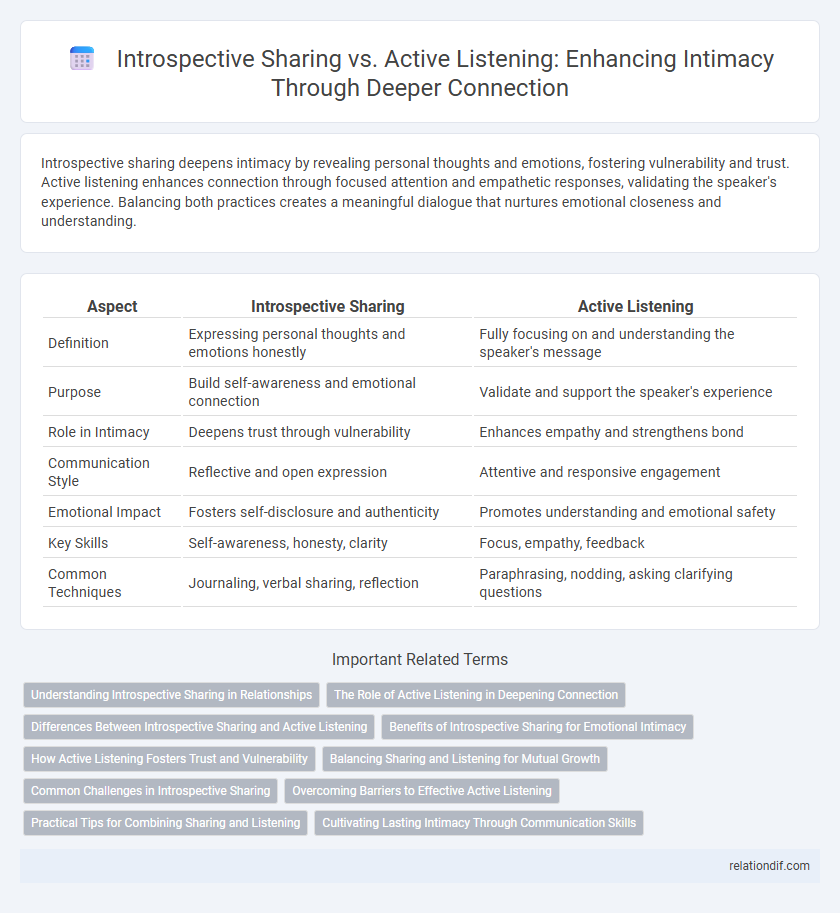Introspective sharing deepens intimacy by revealing personal thoughts and emotions, fostering vulnerability and trust. Active listening enhances connection through focused attention and empathetic responses, validating the speaker's experience. Balancing both practices creates a meaningful dialogue that nurtures emotional closeness and understanding.
Table of Comparison
| Aspect | Introspective Sharing | Active Listening |
|---|---|---|
| Definition | Expressing personal thoughts and emotions honestly | Fully focusing on and understanding the speaker's message |
| Purpose | Build self-awareness and emotional connection | Validate and support the speaker's experience |
| Role in Intimacy | Deepens trust through vulnerability | Enhances empathy and strengthens bond |
| Communication Style | Reflective and open expression | Attentive and responsive engagement |
| Emotional Impact | Fosters self-disclosure and authenticity | Promotes understanding and emotional safety |
| Key Skills | Self-awareness, honesty, clarity | Focus, empathy, feedback |
| Common Techniques | Journaling, verbal sharing, reflection | Paraphrasing, nodding, asking clarifying questions |
Understanding Introspective Sharing in Relationships
Introspective sharing in relationships involves openly expressing personal thoughts and emotions, fostering deeper self-awareness and vulnerability between partners. This process enhances emotional intimacy by allowing individuals to reveal their inner experiences, which helps build trust and mutual understanding. Prioritizing introspective sharing creates a foundation for authentic connection, complementing active listening by encouraging empathy and responsive communication.
The Role of Active Listening in Deepening Connection
Active listening plays a crucial role in deepening intimacy by fostering genuine understanding and emotional safety between partners. By fully engaging with verbal and nonverbal cues, active listening enhances empathy and trust, allowing individuals to feel truly heard and valued. This process creates a safe space for introspective sharing, where vulnerabilities can be expressed without fear of judgment, ultimately strengthening the emotional bond.
Differences Between Introspective Sharing and Active Listening
Introspective sharing involves expressing personal thoughts and emotions to deepen self-awareness and connection, while active listening centers on fully focusing on another person's verbal and nonverbal cues to understand their perspective. Introspective sharing requires vulnerability and self-reflection, whereas active listening demands empathetic attention and minimal interruption. Both skills enhance intimacy but serve distinct roles in communication dynamics.
Benefits of Introspective Sharing for Emotional Intimacy
Introspective sharing fosters emotional intimacy by encouraging vulnerability and self-awareness, allowing partners to connect deeply on a personal level. This practice promotes empathy and understanding, which strengthens trust and emotional bonds. Expressing inner thoughts and feelings helps reveal authentic experiences, creating a safe space for mutual emotional growth.
How Active Listening Fosters Trust and Vulnerability
Active listening fosters trust by creating a safe space where individuals feel truly heard and valued, encouraging openness without fear of judgment. This genuine engagement deepens vulnerability, allowing partners to share more authentic emotions and thoughts. Trust built through active listening strengthens intimacy by promoting emotional connection and mutual understanding.
Balancing Sharing and Listening for Mutual Growth
Balancing introspective sharing and active listening is essential for fostering intimacy and mutual growth in relationships. Introspective sharing allows individuals to express personal thoughts and emotions authentically, while active listening ensures these expressions are received with empathy and understanding. Prioritizing both practices cultivates a dynamic exchange that deepens connection and supports emotional development for both partners.
Common Challenges in Introspective Sharing
Common challenges in introspective sharing include vulnerability barriers, difficulty articulating complex emotions, and fear of judgment or rejection. These obstacles hinder genuine connection and impede emotional intimacy development. Overcoming these challenges requires patience, trust-building, and creating a safe communication space.
Overcoming Barriers to Effective Active Listening
Overcoming barriers to effective active listening requires recognizing internal distractions such as judgment, emotional reactions, and personal biases that hinder true connection. Cultivating mindfulness and empathy enables individuals to remain present and fully engaged during introspective sharing, fostering deeper intimacy. Techniques like reflective paraphrasing and withholding immediate responses promote understanding and validate the speaker's experience, thereby strengthening relational bonds.
Practical Tips for Combining Sharing and Listening
Intimacy thrives when introspective sharing is balanced with active listening, allowing emotional vulnerability to be met with genuine empathy. Practical tips include setting aside distractions to fully engage in conversations, using reflective statements to validate feelings, and scheduling regular check-ins to foster consistent, open dialogue. Harnessing both techniques deepens trust and strengthens relational bonds by ensuring both partners feel heard and understood.
Cultivating Lasting Intimacy Through Communication Skills
Cultivating lasting intimacy hinges on balancing introspective sharing with active listening, allowing partners to deeply understand and validate each other's emotions. Introspective sharing fosters vulnerability and self-awareness, while active listening builds trust and emotional safety by attentively honoring the speaker's experience. Mastering these complementary communication skills enhances emotional connection and nurtures enduring relational closeness.
introspective sharing vs active listening Infographic

 relationdif.com
relationdif.com